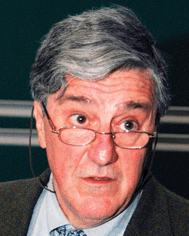Molecule-based magnets†
Joel S.
Miller
a and
Dante
Gatteschi
b
aDepartment of Chemistry, University of Utah, 315 S. 1400 E. RM 2124, Salt Lake City, UT 84112-0850, USA. E-mail: jsmiller@chem.utah.edu
bLaboratory of Molecular Magnetism, Department of Chemistry, University of Florence, Via della Lastruccia no. 3Sesto, Fiorentino (FI) 50019, Italy. E-mail: dante.gatteschi@unifi.it
 Joel S. Miller | Joel S. Miller is a Distinguished Professor of Chemistry at the University of Utah. He has been a Visiting Professor of Chemistry at the Technion, University of Pennsylvania, Universidad de Barcelona, and Professeur Invité, Institut de Science et d'Ingénierie Supramoléculaires (ISIS), Université Louis Pasteur, among other institutions. He was an inaugural member of the advisory board of the Journal of Materials Chemistry, and is currently on the advisory board of Advanced Materials and Chemistry–a European Journal, and a member of the Inorganic Synthesis Corporation. His research interests focus on the solid state magnetic, electrical, and optical properties of molecule-based (organic, organometallic, and inorganic coordination) materials and electron transfer complexes as well as the surface modification of solids. He has edited seventeen monographs and published over 500 papers in these and other areas and was recipient of the 2000 American Chemical Society Award for Chemistry of Materials and the 2007 American Physical Society's James C. McGroddy Prize for New Materials among several other awards for designing and discovering organic-based magnets. |
 Dante Gatteschi | Dante Gatteschi is Professor of Chemistry at the University of Florence. He has had the van Arkel Chair at the University of Leiden, and the Chaire Blaise Pascal at the Université Pierre et Marie Curie of Paris. He has been on the Advisory Board of several important journals including Journal of Materials Chemistry, Advanced Materials and Angewandte Chemie. His research interests are framed in molecular magnetism where he has brought important contributions in the development of the metal radical approach, the discovery of single molecule magnets and the use of several spectroscopic techniques to characterize the magnetic properties of molecular magnets. He has published more than 600 papers in high impact journals and was recipient of the Europhysics Prize in 2002 and the EPR Bruker Award in 2000 among several other awards, and was President of the European Institute of Molecular Magnetism. |
The past few decades have witnessed a worldwide renaissance of magnetochemistry to molecular-based magnetism due to a focus on new materials with unusual combinations of physical properties. This is attributed in large part to contributions from molecular chemistry. Molecules offer chemical control akin to the development of pharmaceuticals and distinctly different structure types with respect to conventional magnets, and thus provide the opportunity for new phenomena, and combinations of properties not observed for classical magnets. One of the milestones was the 1st organic-based ferromagnet, i.e. ionic, ‘zero-dimensional’ (0-D), organic-solvent soluble [Fe(C5Me5)2]˙+[TCNE]˙− (TCNE = tetracyanoethylene) would not have been predicted to magnetically order based on the then conventional understanding of magnetism. This is due to the long nonbonded distances between spins. This and numerous other results have generated excitement, which continues and is still expanding today.
Molecule-based materials exhibiting exciting interesting magnetic behaviors that include magnetic ordering with ordering/critical temperatures (Tc) exceeding room temperature, single molecule/chain quantum effects, magnetic state switching via photo, thermal, pressure etc. control is at a stage where selected topics are poised for reflection via reviews to assess the field that includes a perspective for future opportunities. The entire area is too vast to summarize, and certain topics have been recently reviewed; hence herein key and emergent areas are reviewed to provide an impetus to stimulate rapid progress.
A summary of the important aspects of magnetism pertaining to organic/molecule-based magnets, including the determination of the several magnetic phenomena and magnetic ordering temperature (Tc) and a broad array of these magnetically ordered materials are reviewed from a perspective of the structural dimensionality by Miller (DOI: 10.1039/C0CS00166J).
A crucial aspect has been the formation of thin film magnetic materials and this is described in detail by Talham and Meisel (DOI: 10.1039/C1CS15015D). Recent developments are the focus of the timely contribution by Bousseksou, Molnár, Salmon and Nicolazzi (DOI: 10.1039/C1CS15042A).
Weng, Wang and Gao explore novel weak ferromagnets possessing extended network structures (DOI: 10.1039/C0CS00093K). In addition molecule-based magnets based on second and third row transition metal ions as well as lanthanide ion based magnetic materials are the focus of contributions by Wang, Avendaño and Dunbar (DOI: 10.1039/C0CS00188K), and Sorace, Benelli and Gatteschi (DOI: 10.1039/C0CS00185F), respectively.
Multifunctional magnetic materials that combine porosity are elaborated on by Dechambenoit and Long (DOI: 10.1039/C0CS00167H) and those possessing chirality and seeking molecule-based ferroelectric materials are reviewed by Train, Gruselle and Verdaguer (DOI: 10.1039/C1CS15012J). Aspects of the emerging area of spin polarized conducting/magnetic materials and spintronic applications are focused on by Sugawara, Komatsu and Suzuki (DOI: 10.1039/C0CS00157K) and Sanvito (DOI: 10.1039/C1CS15047B), respectively.
Cornia, Mannini, Sainctavit and Sessoli describe the state-of-the-art of the organization of single molecule magnets on surfaces (DOI: 10.1039/C0CS00187B).
Crucial progress in understanding and using molecule-based magnets requires an in-depth knowledge of the fundamental basis of relevant magnetic phenomena and this is provided by Novoa, Deumal and Jornet-Somoza (DOI: 10.1039/C0CS00112K) who review exchange coupling and their modeling. Palii, Tsukerblat, Klokishner, Dunbar, Clemente-Juan and Coronado expand this to systems with unquenched orbital angular momentum (DOI: 10.1039/C0CS00175A). This leads to magnetic anisotropies and Oshio and Nakano (DOI: 10.1039/C0CS00223B) describe this in the context of polynuclear metal complexes.
Information storage aspects of molecule-based magnets are summarized from a materials perspective by Timco, Faust, Tuna and Winpenny (DOI: 10.1039/C0CS00151A), and theoretical vantage by Troiani and Affronte (DOI: 10.1039/C0CS00158A).
The key topic of organic radical-based multifunctional molecule-based materials has been reviewed by Ratera and Veciana, but while not included in this Chem Soc Rev themed issue, this will appear in an upcoming issue of this journal.
Footnote |
| † Part of the molecule-based magnets themed issue. |
| This journal is © The Royal Society of Chemistry 2011 |
